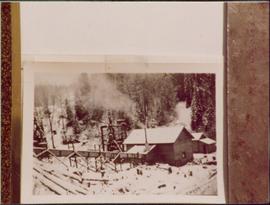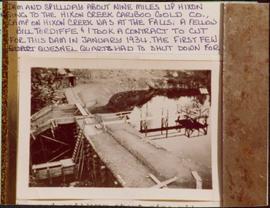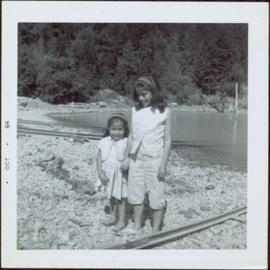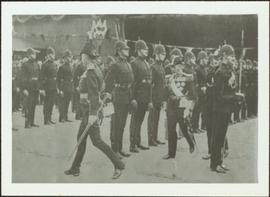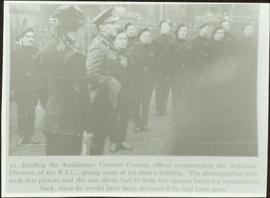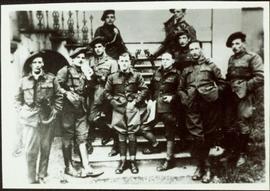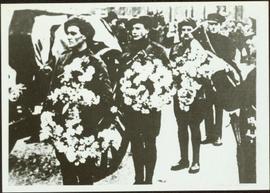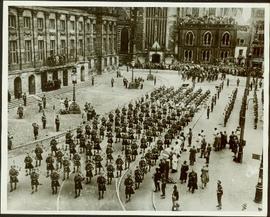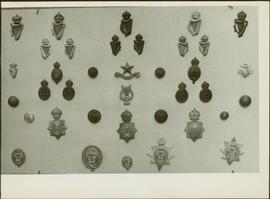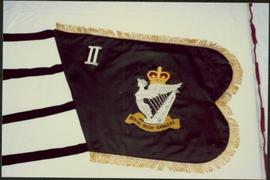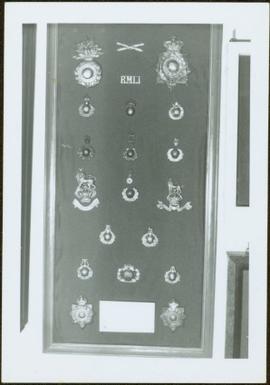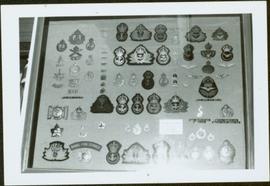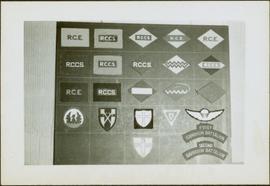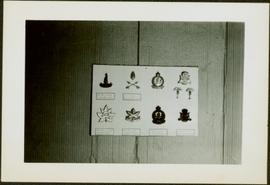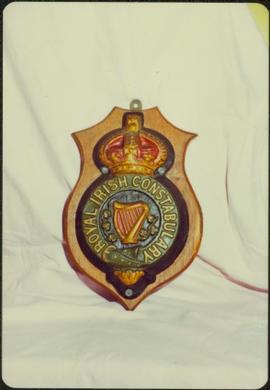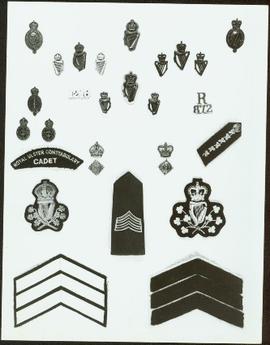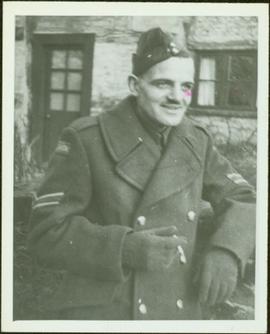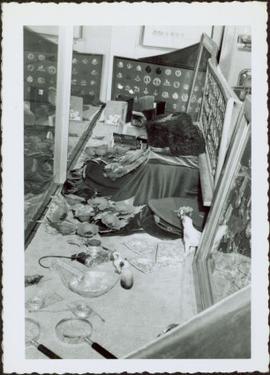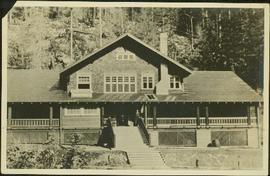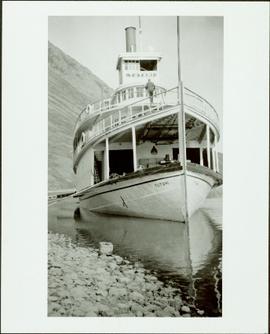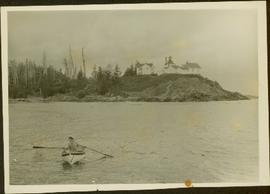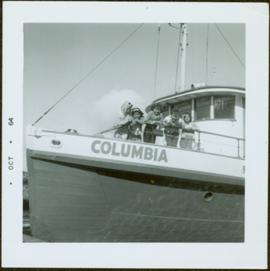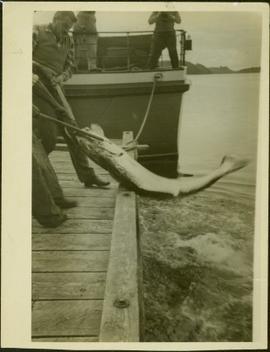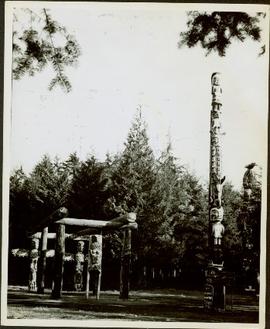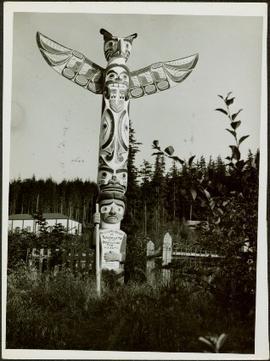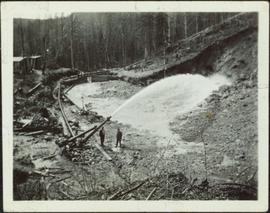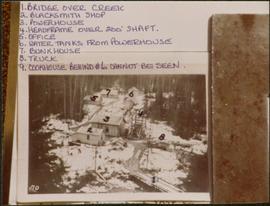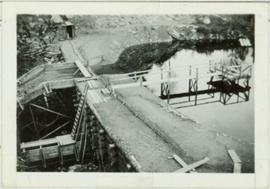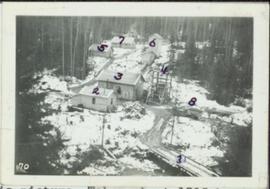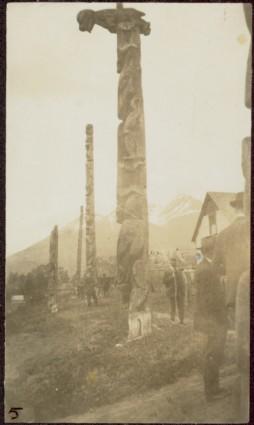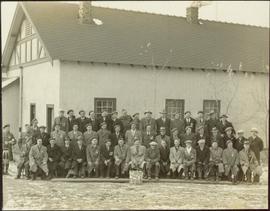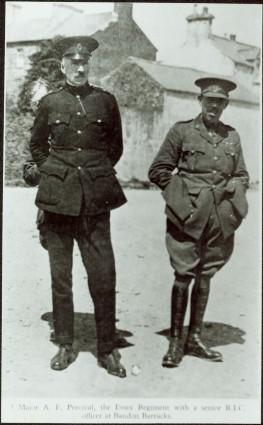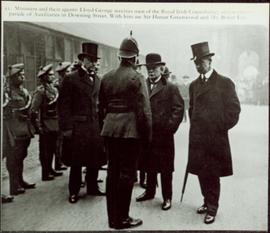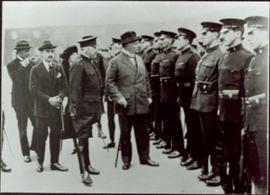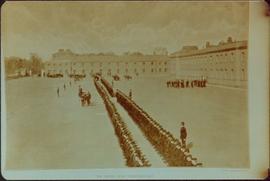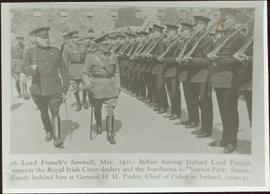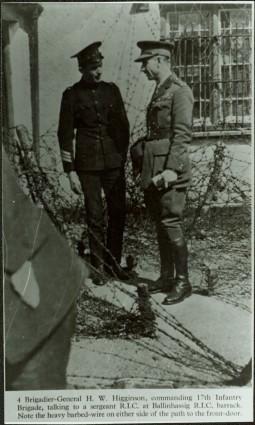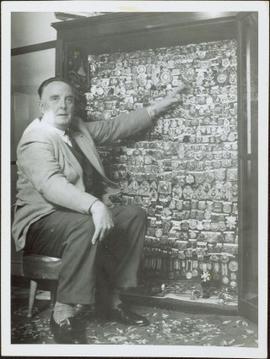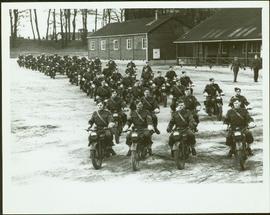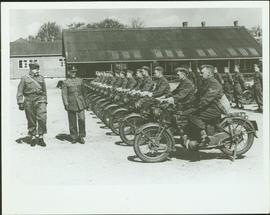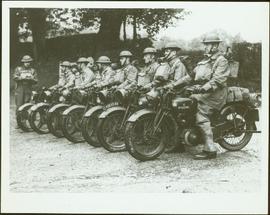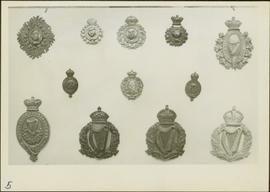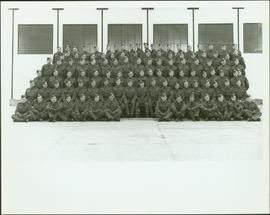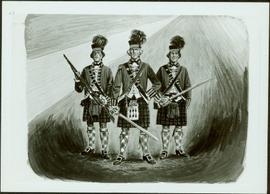Collection consists of 140 photographs pertaining to the life and pursuits of James Joseph Claxton over the course of sixty years. Subject areas identified within this collection include: quartz and placer mining in the Cariboo; Kingcome Village; the Royal Irish Contabulary; Roderick's Jewelers, New Westminster; the "M.S. Columbia III"; Kwakiutl petrographs in Fort Rupert; totem poles at Alert Bay; and the Salmon Arm Boy Scouts of Canada group.
Claxton, James JosephPhotograph depicts two wooden buildings in a snow covered forest environment. Photo is adhered to paper backing, upon which handwritten annotation on recto reads: “Quesnelle Quartz Mining Co. Hixon BCTaken in mid 1930ies. Power house from rear. Present day (1973) Logging road would run through powerhouse at immediate rear of it at which you are looking. Tom Marsh Box 150 Squamish BC 1978.12”
Photograph depicts a dam and spillway obstructing a creek. Photo is adhered to paper backing, upon which handwritten annotation on recto reads: “This is the dam and spillway about nine miles up Hixon Creek belonging to the Hixon Creek Cariboo Gold Co., whose main camp on Hixon Creek was at the falls. A fellow Sterling or Bill Tordiffe & I took a contract to cut the logs for this dam in January 1934. The first few winters Quart [sic] Quesnel Quartz had to shut down for snow”
Photograph depicts two unidentified, young First Nations girls standing hand in hand on a rocky beach. Rail tracks extending from the water to the shore are visible in the lower right corner and in the background. Handwritten annotation on verso reads: “Kingcome Reserve”
Photograph depicts Royal Irish Constabulary constables lined up for inspection as King George V walks past.
Photograph depicts two rows of men in military uniform being given a briefing by a man in the foreground of the image. Typed annotation on recto of photograph reads: "Briefing the Auxiliaries: General Crozier, officer commanding the Auxiliary Division of the R.I.C., giving some of his men a briefing. The photographer who took this picture and the one above had to hide his camera behind a bystander’s back since her would have been arrested if he had been seen.”
Photograph depicts a casual group photo of Royal Irish Constabulary auxiliary members standing at ease in front of a set of stairs. Handwritten annotation on verso of photo reads: “A group of Auxiliaries, Dublin, 1920”
Photograph depicts three uniformed men, holding memorial wreaths lined up beside a casket on a wagon. Handwritten annotation on verso of photo reads: “The funeral of British Agents shot on Bloody Sunday. Auxiliaries and R.I.C. form Guard of Honour.”
Photograph depicts a large liberation parade with people marching with bagpipes and flags. Handwritten annotation on verso reads: "Aug 28/45 Amsterdam, Holland Massed Band Liberation Parade."
Photograph depicts a close-up of thirty-seven Royal Irish Constabulary badges.
Photograph depicts a close-up of a Royal Irish Rangers bagpipe banner featuring embroidery of a harp with a crown on top. Embroidered banner on pipe banner states "Royal Irish Rangers". Handwritten annotation on verso reads: “Pipe Banners presented to 2nd BN Royal Irish Rangers by Van. Irish Fug Assn. St Patricks Day 1982”. Item believed to be a part of J.J. Claxton's collection of police memorabilia.
Photograph depicts a collection of twenty-four RMLI badges in a frame believed to be a part of J.J. Claxton's collection of police memorabilia.
Photograph depicts a framed collection of military badges made of metal and embroidered fabric believed to be a part of J.J. Claxton's collection of police memorabilia.
Photograph depicts a collection of twenty-three fabric military badges. Visible crests can be seen with the following words: “First Garrison Battalion” and “Second Garrison Battalion”, as well as the following acronyms: "R.C.E." (Royal Canadian Engineers?) and "R.C.C.S." (Royal Canadian Corps of Signals?) Framed military badges believed to be a part of J.J. Claxton's collection of police memorabilia.
Photograph depicts a collection of eleven metal military badges believed to be a part of J.J. Claxton's collection of police memorabilia.
Photograph depicts a close-up of Royal Irish Constabulary helmet. Item believed to be a part of J.J. Claxton's collection of police memorabilia.
Photograph depicts a Royal Irish Constabulary wall plaque depicting a harp surrounded by text stating "Royal Irish Constabulary" and a crown. Item believed to be a part of J.J. Claxton's collection of police memorabilia.
Photograph depicts a close-up of two Royal Irish Constabulary badges, two buckles and a whistle chain. Item believed to be a part of J.J. Claxton's collection of police memorabilia.
Photograph depicts a close-up of twenty-one Royal Irish Constabulary badges and seven arm crests. Item believed to be a part of J.J. Claxton's collection of police memorabilia. Sticker on verso reads: “Ulster Museum Copyright not to be reproduced without written permission.”
Photograph depicts James Joseph Claxton wearing a cold weather uniform while in Surrey, England. Handwritten annotation on verso reads: “J J C Witley Surrey Eng”
Photograph depicts four frames of James Joseph Claxton's military badge collection in a window display with ceramics, magnifying glasses, and military hats included in the window case. Handwritten annotation on verso reads: “Nov 11th Window 1951 Roderick Jewellers Part of JJC’s badge collection.”
Photograph depicts an unidentified man standing on the porch of a large house in front of a forest.
Photograph depicts the multi-level steamship "Tutshi" anchored near a rocky shoreline. Stamped annotation on verso: “Yukon Archives, Whitehorse. Print No. No. 82/378 #3; Please credit: Poirer Collection, Yukon Archives”
Photograph depicts a woman wearing a Cowichan sweater rowing a boat away from a rocky island with a lighthouse. Handwritten annotation in pencil on verso reads: “Gal in boat wearing Indian sweater knit by my mother Eileen M. Jackson (she also spun the wool) for her brother J.J. Claxton, cook on the Columbia Coast Mission Boat. - S.K. Jackson”
Photograph depicts five First Nations children leaning over the deck on the M.S. Columbia. Stamped annotation on recto: “Oct – 64”. Handwritten annotation in pen on verso reads: “Mamalicula”
Photograph depicts a man on a boat standing with his back to the camera while holding a fishing rod. A waterfall and rocky cliff face are visible in the background. Handwritten annotation in pencil on verso reads: “Jim M.V. Columbia 1959”
Photograph depicts James Joseph Claxton and an unidentified man pulling a large fish onto a dock with a peugh. Handwritten annotation in pencil on verso reads: “x JJC"; "C/C Missions”
This file consists of 11 photographs taken by photographer W.E. Nicholson, featuring various totem poles at Alert Bay, BC.
Photograph depicts several carved totem poles and house posts in a clearing with a forested area in the background. Photographer’s stamp on verso: “W.E. Nicholson, 268 E. 10th, Vancouver 10, B.C.”
Photograph depicts a memorial totem pole in front of a fence line and a forested environment. Inscription on memorial pole states: “In loving memory of Tlaqwa Latle of the Qidwasudinuk Tribe, Died Nov. 9 - ” Photographer’s stamp on verso: “W.E. Nicholson, 268 E. 10th, Vancouver 10, B.C.”
Two men stand below a large upright hose that is spraying a powerful stream of water against the side of a rocky hillside. Annotation on verso of photograph states: "Placer Mining Hixon (Hungry Thirties) This picture taken on top off Hill Across from Ques. Qarts. Maybe 800 Ft. west of Quarty There pictures taken approx 45 years ago Your friend(?) Box 156 Squamish B.C. Dec. 19/78"
Annotated overview of the Quesnel Quartz Mine Camp, with buildings numbered and a corresponding legend provided. Annotation on recto of photograph states: "1. BRIDGE OVER CREEK 2. BLACKSMITH SHOP 3. POWEROUSE 4. HEADFRAME OVER 200' SHAFT 5. OFFICE 6. WATER TANKS FROM POWERHOUSE 7. BUNKHOUSE 8. TRUCK 9. COOKHOUSE BEHIND #6 CANNOT BE SEEN" Additional annotation associated with photograph states: "We were always able to find the cookhouse even though hidden in this picture. Taken about 1935 by Russell Ross Supt. Quesnel Quartz Mine"
Photograph depicts a dam and wooden spillway along a creek. Annotation on verso reads: "This is the dam and spillway about 9 miles up Hixon Creek belonging to the Hixon Creek Cariboo Gold Co. Original handwritten annotations on verso of photograph are signed by Tom Marsh and covered by mounting the photo on paper. Photograph is taped to paper. Typed annotation on recto of paper reads: “This is the dam and spillway about nine miles up Hixon Creek belonging to the Hixon Creek Cariboo Gold Co., whose main camp on Hixon Creek was at the falls. A fellow Sterling or (Bill) Tordiffe & I took a contract to cut the logs for this dam in January 1934. The first few winters Quesnel Quartz had to shut down for snow."
Photograph depicts a snow-covered forest clearing with six structures and a truck. Buildings have been numbered 1-8 with pen. Original handwritten annotations on verso of photograph are signed by Tom Marsh. Photograph is taped to paper. Typed annotation on recto of paper reads: “1. Bridge over creek. 2. Blacksmith shop. 3. Powerhouse. 4. Headframe over 200’ shaft. 5. Office 6. Water tanks from powerhouse. 7. Bunkhouse. 8. Truck. 9. Cookhouse behind #6 cannot be seen. We were always able to find the cookhouse even though hidden in this picture. Taken about 1935 by Russell Ross, supt. Quesnel Quarts Mine. Tom Marsh, Box 156, Squamish B. C.”
This file consists of 3 photographs featuring various perspectives on Kingcome Inlet, such as the interior of St. George's Church (Anglican); totem poles; and children on the beach.
Unidentified people stand around and between totem poles. A row of buildings and snowy mountain peaks are visible in the background. Location is believed to be Kingcome Indian Village
Formal portrait of a large group of older men standing outside an unidentified building. Snow is still visible in the foreground and men are displaying medals on the front of the heavy overcoats. Handwritten annotation on verso reads: "James Joseph Claxton third right, middle row"; "Toc H Kelowna" ; "Toc H?".
Photograph depicts two men in military uniforms standing in front of several ivy covered buildings. Typed annotation on recto of photograph states: "Major A. E. Percival, the Essex Regiment with a senior R.I.C. officer at Bandon Barracks."
Photograph depicts five men in top hats and overcoats greeting several men in military uniform. Typed annotation on recto of photograph states: "Ministers and their agents: Lloyd George receives men of the Royal Irish Constabulary and reviews a parade of Auxiliaries in Downing Street. With him are Sir Hamar Greenwood and Mr. Bonar Law."
Photograph depicts members of the Royal Irish Constabulary lined up for inspection as an unidentified English VIP walks past.
Photograph depicts an overview of a large formation of Royal Irish Constabulary constables lined up for inspection by the Director General in the courtyard of Garda Headquarters, "The Depot," located in Phoenix Park, Dublin, Ireland. Typed annotation on recto of photograph states: "The Royal Irish Constabulary"
Photograph depicts Lord French and several other men in military uniform inspecting a row of Royal Irish Constabulary officers. Typed annotation on recto of photograph reads: “Lord French’s farewell, May 1921: Before leaving Ireland Lord French inspects the Royal Irish Constabulary and the Auxiliaries in Phoenix Park. Immediately behind him is General H.H. Tudor, Chief of Police in Ireland, 1920-21.”
Photograph depicts Brigadier-General H.W. Higginson in conversation with a Royal Irish Constabulary sergeant. Typed annotation on recto of photograph reads: “Brigadier-General H.W. Higginson, commanding 17th Infantry Brigade, talking to a sergeant R.I.C. at Ballinhassig R.I.C. barrack. Note the heavy barbed-wire on either side of the path to the front-door.”
Photograph depicts an unidentified man sitting on a stool pointing to a large wooden display case filled with Royal Irish Constabulary medals and badges. Handwritten annotation on verso of photograph states: "JJC badges"
Photograph depicts the No. 1 Canadian Provost Corps riding in formation within camp compound. Two unidentified officers seen watching in the background. Stamped annotation on verso reads: "Negative No. 2043. [----] when reordering."
Photograph depicts two unidentified officers inspect the first row of motorcycle corps members. Handwritten annotation on verso reads: "No. 1 Provost Coy, England 1940". Stamped annotation on verso reads: "[--]tive No. 5629. Please quote when reordering."
Photograph depicts seven men wearing full outdoor motorcycling gear and carrying rations, line up in a row listening to an unmounted man read orders. Handwritten annotation on verso reads: "No. 1 Provost Coy, England 1940". Stamped annotation on verso reads: "Negative No. 1011. Please quote when reordering."
Photograph depicts a close-up of twelve Royal Irish Constabulary badges. Handwritten annotation on verso reads: “Royal Irish Constabulary badges from the JJ Claxton Collection”
Photograph depicts a large group of uniformed No. 1 Canadian Provost Corps men posing for a formal portrait at Canadian Forces Base, Rockcliffe in Ottawa, ON. Handwritten annotation on verso reads: "Rockcliffe 1939". Stamped annotation on verso reads: "Negative No. 662, Please quote when reordering"
Photograph depicts the a painting of three men in the Royal Highland military uniforms. Typed annotation glued to verso of photograph provides an interpretation of this piece of art: "The 42nd (Royal Highland) Regiment of Foot - 1782. The first battalion of this British regiment arrived in New York in 1756. After serving in numerous campaigns and engagements in North America, the 42nd (Royal Highland) Regiment of Foot garrisoned in Nova Scotia. It is from this famous regiment that the Black Watch (Royal Highland) Regiment of Canada derives its name and much of its colorful dress and traditions."; "Le 42nd (Royal Highland) Regiment of Foot - 1782. Le premier bataillon de ce régiment britannique arriva à New-York en 1756. Après plusieurs campagnes en Amérique du Nord, il fit garnison en Nouvelle-Ecosse. C'est de ce fameux régiment que s'inspirent les uniformes et les traditions du Black Watch (Royal Highland) Regiment of Canada. Cornemuses et tambours y ont toujours joué un rôle important et pittoresque."
